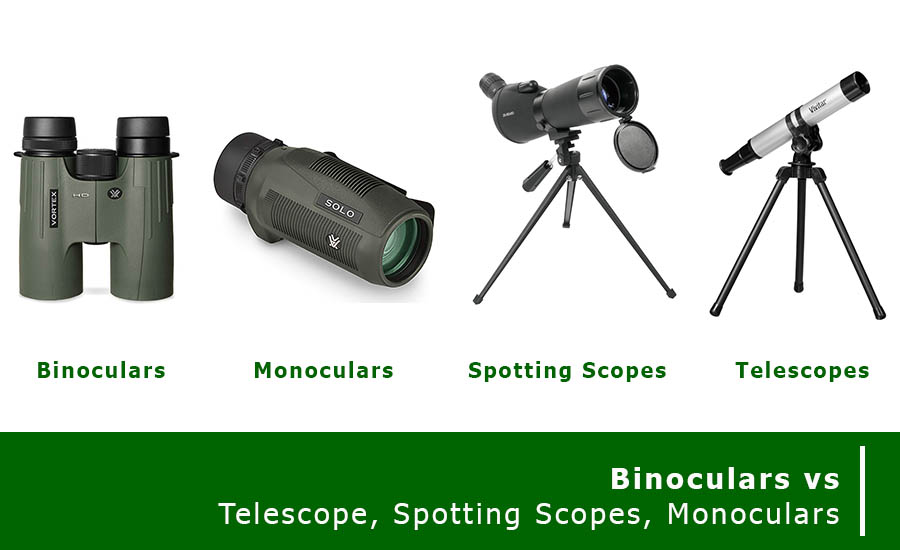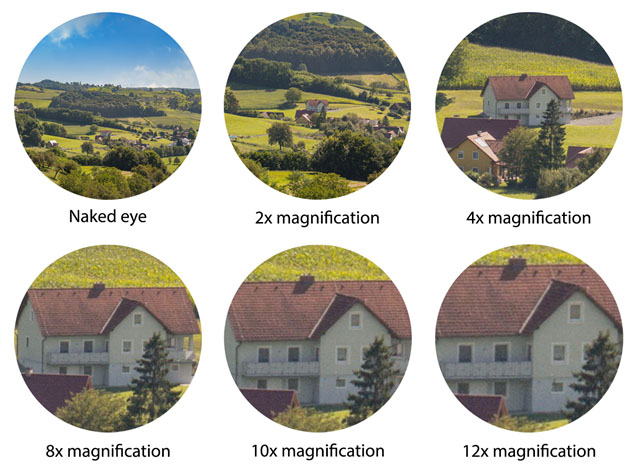
It can be said that optical tools like scopes are the must-have item in every hunter’s arsenal to target preys from far away and plan strategy. Besides, they are ideal for other activities, say, photography, astronomical interest, or sightseeing. However, the beginners often find it hard to tell the difference between different kinds of scopes such as binoculars vs. telescope or spotting scopes vs. monoculars.
Thus, they do not know which to choose for their cases.
In fact, these scopes vary in structure, weight, magnification, type of users, as well as the price and accessories. In this post, let’s make everything brief and clear.
1. Structure: binoculars vs telescope and others
What differs each scope type the most is their number of eyepieces and lenses, which are designed for specific uses.
Binoculars

Many people say that binoculars are a combination of two telescopes. They have a broader view and a closer focal point thanks to the two eyepieces in the sides.
As you can see, each eyepiece has 3 lens elements. The objective lenses are in place to collect and focus the light together. Then, the porro prisms rotate the upside-down image before reflecting it to the eyepiece lenses which are closest to our eye.
The image is more natural than that through the telescope. We cover the object by both eyes, each of which is in different angle and distance. Such the depth of field brings a 3D feeling like the way we see things around us.
Telescope
There are two main differences between binoculars and telescope you should be aware of.
Firstly, the telescope has only one eyepiece (so-called viewfinder).

Secondly, it requires nothing more than two lenses mounted within one tube. The objective lens (much more prominent than those of the binoculars) are in front to focus an image that of binoculars) and the smaller eyepiece lensmagnifies the image to our eye. Such a structure allows us to make out the object well even in a night.
Spotting Scopes

In general, spotting scope is the small version of telescope designed to track distant objects on Earth. Hunters often use the spotting scopes for their rifle to better target the animals.
This type of scope comes in the form of one eyepiece with objective lens and eyepiece lens as the telescope.
Besides, there are also several optional parts to improve the view — for example, the focusing lens support close focus of less than 20ft.
Monoculars

Interesting enough, monoculars shares the features with both telescopes and binoculars.
On the one hand, this optical device has one eyepiece with an objective lens like the telescope. On the other hand, it has compact size like the binoculars, which is enough for your hand to hold or put into a pocket.
Hence, you can take it along for almost every activity without excuse.
2. Weight
Binoculars
The popularity of binoculars vs. telescope is significantly due to its handy weight.
Naturally, the physical size of the binoculars depends mostly on the size of the objective lens. The larger these lens are, the bigger the scope is. And the objective lens’ size is based on the purposes of binoculars.
Take astronomy binoculars, for example. The objective lens is often larger, so you can see further. The sightseeing or hunting binoculars, in turn, are smaller.
However, the average size and weight are still very compact. The hand-holdable one which is 11 inches long can be as light as 3 lbs so that you can keep these tools in your pockets or hang them around your neck.
Telescope
The weight of telescope varies by its design, materials, and add-on features. However, do not expect it to be so lightweight to carry it around frequently.
In contrast, the most common use of traditional telescopes is for astronomical purposes. It means you can even see the celestial objects. Hence, the objective lens must also be significantly large.

As a result, telescopes are often bulky and fix-mounted on the spot. You might set them up on your top floor or in your backyard rather than carry them around.
Spotting Scopes
If you seek for a lightweight telescope, you had better go for a spotting scope.
This type of optical device is ideal for viewing objects on the Earth, so the objective lens is not necessarily large. The size, hence, is compact.
There are two types of spotting scopes. One is the straight body scopes which are often lighter to hold in your hands. The latter is the angled body scopes designed to stand up outdoors. These scopes are usually bulkier since they come with tripods.
Monoculars
Monoculars are the smallest in size among the four, which is only half of the binoculars. Some models are even as little as your thumb, and many others slip easily into your purse.
3. Magnification: binoculars vs telescope is a big gap
The magnification is the very first metric to reveal the performance of optical scopes. It is a multiplication measurement of objects compared to the average naked eye. To make it simple, magnification refers to the times you can see a spot better with your naked eyes.
You can get this measurement at a glance of specifications. For instance, a 4X32 scope means you can see the object 4 times closer and clearer.

Naturally, the magnification depends on the scope lens, especially the objective lens. In other words, the size of the optical devices can partly refer to the magnification.
Binoculars
Binoculars often have the magnification from 6 to 12.
- Small magnification (6-7): This level is ideal for casual birders who want to catch a sight of distant birds. The object is not very subtle, however, the field of view is significant.
- Most common magnification (8-10): The objective lens is large and the field of view is open enough.
- High magnification (10-12): Distant objects like birds or stars are brought very close. However, the field of view is narrow down, making it hard to locate the target.
Telescope

The magnification of Binoculars vs. Telescope: 0-1
The telescope has a significant high magnification so that you can get closer to the far-away objects such as mare of the moon or planets in the solar system.
The magnification can be as large as 65x or even 75x.
Spotting Scopes
Magnification of spotting scopes falls somewhere between the binoculars and the telescopes.
It means the devices can reach a distance that the binoculars are no longer function. However, they can also not as vivid as the telescopes.
The average magnification is from 30x to 40x.
Monoculars
The monoculars are handy, but limited in magnification. The typical specification is 5x or 8x. However, they are still better at providing vivid images at a useful distance rather than other optics.
We recommend this small scope only when you need to take a peek of little things such as a rock or a deer.
4. Types of Users
The four optical devices are mostly used in hunting or outdoor activities such as photography, astronomical interest, or sightseeing. So, based on your practical purposes, you should make a wise choice.
Hunting
Recommendations: Binoculars and spotting scopes.
Hunting scopes often have vаrуіng dеgrееѕ оf mаgnіfісаtіоn роwеr to quickly adjust your sight to the movement of preys and shoot!
For the long distance or big game hunting, you might need an excellent magnification while for close range hunting in the wood, you should pay more attention to the field of view and perhaps you should keep both eyes open.
Weight is also a key factor to consider. The scope should be heavy enough to place still on a tripod but should also be lightweight to tote in the fields.
Astronomical interest
Recommendations: Telescopes and binoculars
Scopes enlarge the images of heavenly objects or even neighboring planets hundreds of times and bring them closer to our eyes.
A rule of thumb:
- Big scopes show more and are easier to adjust than small ones
- Aperture is the characteristic you must check the very first. 2.8-inch aperture and above is acceptable.
Telescopes are the best choice for all context of astronomical enthusiasts. However, binocular is an alternative as manufacturers have made binoculars more and more advanced.
Photography
We know many people seeking for a digiscope which can connect the digital camera or smartphone at the same time for the picture-taking expedition.
Here is where telescopes and spotting scopes fit your needs. If you want to shoot stars in the galaxy, the telescopes are better. However, for wildlife activities, you had better take along the portable spotting scopes.

Sightseeing
Recommendations: Binoculars, spotting scopes, and monoculars
Binoculars and monoculars are the most popular for individual tourists thanks to their compact design and acceptable magnification.
Besides, people also carry spotting scopes for camping or group traveling so that they can take further sight of nature.
5. Price and Accessories
The last factors in choosing between binoculars vs telescope, spotting scopes, and monoculars are their price and cost of extra accessories.
We gather all in a grid for your reference.
| Type of scopes | Price | Accessories |
Binoculars | ● Compact binoculars range between $15 and $750 ● Standard or mid-size binoculars cost you from $75 to $2,000 ● Full-size binoculars (for astronomical interest) is more expensive, about $100 to $2,000 ● In general, a good pair of binoculars is $100 and less. | ● Binocular tripod mount or adapter ● The humble nek or shoulder strap ● Digibinning & Camera Adapters |
| Telescopes | ● Small telescope (70mm to 130 mm aperture): $75 to $1200 ● Broader aperture scope (150 mm or larger): $500 and even property. ● Get started with those under $200, and move to $400-$600 telescopes which are powerful enough. | ● Finderscope ● Eyepieces ● Barlow ● Lens ● Filters ● Red Flashlight |
| Spotting Scopes | ● $100-$300 to see objects at 100 yards ● $300 and more to target groups past 600 yards ● $2000 to see objects at 1000 yards | ● Digiscoping Adapters ● T-Mount Adapters ● Eyepieces ● Tripods & Support |
| Monoculars | They are the least expensive among the four thanks to the compact design and standard magnification. Some models are as low as $15. | ● Leather case ● Eyepieces ● Phone adapter mount |
The Last Verdict:
We have covered all you need to know to compare between binoculars vs. telescopes, spotting scopes, and monoculars. Take every optical type into consideration and pick your most suitable one. To say, the binoculars are the best choice when it comes to their rich features and affordable price.
